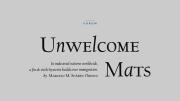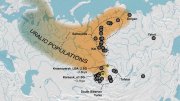Refugees from the murderous wars in Sudan, Libya, and Syria, walking north toward havens in Europe or risking their lives on overcrowded boats in the Mediterranean. Asylum-seekers heading toward the United States from homicidal gang wars and economic stagnation in Central America. The Rohingya, driven from Myanmar to barely habitable camps in Bangladesh. These peoples all figure in the rising salience of immigration as a toxic political, economic, tribal, and racial issue across much of the developed, and part of the developing, world. The current wave of people moving from fear and want to places they perceive as havens, and the increasingly strident reaction to their arrival, have long been building. Then-faculty member Marcelo Suárez-Orozco, a scholar of migration, now dean of UCLA’s Graduate School of Education and Information Studies, wrote nearly a quarter-century ago that “Public opinion has turned rapidly and decisively against both legal and undocumented immigration. The language of the new immigration is the apocalyptic language of deluge: ever-growing ‘waves’ of immigrants are said to be ‘flooding’ the shores of the more developed world.” Whatever the volume of future migration, the inflamed reaction he described then, republished now, seems likely to persist for a long time. ~The Editors
Throughout the major postindustrial societies, few topics today provoke as much passion as the issue of immigration: legal and undocumented migrants, the growing numbers of asylum seekers, and the adaptation problems of the children of immigrants.
People on both sides of the Atlantic feel that the world around them is sinking, and that the islands of privilege in Europe and North America simply cannot rescue all those who need help. Public opinion has turned rapidly and decisively against both legal and undocumented immigration. The language of the new immigration is the apocalyptic language of deluge: ever-growing “waves” of immigrants are said to be “flooding” the shores of the more developed world. Rickety boats carry undocumented immigrants and asylum seekers to the coasts of Florida and New York, and to the coast of Mediterranean Europe.
In a number of nations—most of Western Europe and the United States—that in the recent past welcomed immigrant laborers, indeed actively recruited them, strikingly similar currents of opposition are now evident. The hateful winds of xenophobia sweep through France and Belgium, where surveys in Brussels, for example, suggest that a large majority of voters would like to see the immigrants go back home. Germany, which until recently granted refuge generously, now severely restricts would-be asylum seekers’ access.
The argument over immigration has entered a decidedly post-utopian realm. Long privileged notions of immigrant “assimilation,” “acculturation,” and multiethnic harmony have been overwhelmed by neonativistic anxieties. In France, the once reigning notion that French culture could assimilate all immigrant groups has been guillotined. A town in southern France recently passed an ordinance banning immigrants from settling within city limits. In neighboring Flanders, voters in late 1994 elected a member of the neo-Nazi Vlaams Bloc mayor of Antwerp. The Vlaams Bloc’s rather narrow political platform is well captured in their slogan, “Our people first, seal our borders, send the immigrants home.” In Austria, the leader of the far right Freedom Party made immigration a key theme in a recent electoral campaign.
In the United States, Congress has considered several bills that would reduce the numbers of new documented immigrants the country will accept. Our government is also experimenting with new ways to best secure the southern border from undocumented arrivals, and debating to what extent documented immigrants should be allowed to use an array of public services. In November 1994, California voters overwhelmingly approved Proposition 187, which aims, inter alia, to exclude an estimated 300,000 undocumented immigrant children from public elementary and secondary schools.
Freud claimed that hysteria was the malaise of his civilization. As we approach the end of this century, hysteria over immigration has become one of the great discontents of our civilization. Before we can treat this hysteria, we face the task of carefully considering the relative importance of fact and fantasy in its makeup.
What are the facts about the new immigration? First, much of the current immigration crisis in the postindustrial democracies is of their own making. Policies aimed at recruiting foreign workers to feed a voracious appetite for inexpensive labor ignited much of the recent undocumented population movement, both in the United States and throughout Western Europe. California governor Pete Wilson—who briefly fantasized that he could surf the anti-immigration wave all the way to the White House—long promoted policies to import foreign workers for California’s big agribusinesses when he was a U.S. senator. By one account, the several hundred thousand “temporary” immigrants he helped bring into the country to harvest crops turned into more than one million permanent residents.
Second, even with high unemployment among native workers (particularly in Western Europe, where, on average, unemployment rates are twice the U.S. rate), some sectors of the market continue to rely on foreign workers to do the impossible jobs nobody wants to do. The Japanese call them the “three-k jobs,” for the Japanese words for dirty, dangerous, and demanding work. Just days after passage of Proposition 187, Pete Wilson called for a new guest-worker program to bring temporary farm laborers to California. The same year, a hard-line anti-immigrant member of the French cabinet announced that 100,000 foreign workers would be needed each year to fill jobs French workers cannot or will not do. There are similar reports from Belgium and Germany.
Third, much recent immigration has been a by-product of stunning global economic and political transformations. Ease of transportation and liberalization of Third World economies (in much of Latin America engineered largely by economists trained in the United States) have stimulated significant migration. Over the next two decades, economic changes brought about by the North American Free Trade Agreement will push perhaps two to three million Mexican farmers off the land. (They might well look north, since the U.S.-Mexican wage differential is about 12 to 1.)
Very similar dynamics are at work in Western Europe. Political upheaval and the spread of ethnonationalistic conflicts—as in the former Yugoslavia—have accelerated population movements. European officials are keeping a cautious eye on developments in the Maghreb in general and in Algeria in particular. The fall of the current Algerian regime could produce a mass exodus to France. Even without such a crisis, many pressures propel people to move: more than half of the Maghreb’s population is below the age of 25, while Europe’s population is aging; unemployment rates in North Africa are much higher (about 50 percent in Algeria) than in the industrial economies; and the wage differentials are extreme, too (the French gross domestic product per capita is eight times the Algerian). Moreover, population growth will continue to be a factor in international immigration.
In light of these causes of immigration, the transatlantic debates share a common vocabulary. I discern six distinct but related areas of concern.
First is a feeling that there are simply too many new arrivals. Since 1990 Germany has processed over one million asylum cases. The United States now receives on average about a million new documented immigrants and an estimated 200,000 to 400,000 new undocumented immigrants each year.
A second concern is rooted in the feeling that limits on immigration, including employer sanctions, have largely failed to contain the undocumented immigrants and asylum seekers arriving year after year—that, in the words of the head of the immigration program at the Carnegie Endowment for International Peace, the public senses that “immigration is out of control.” (The most recent U.S. Senate bill to tackle the issue, debated in May, requires that a national database be established so employers may verify the immigration status of their prospective employees.)
A third concern relates to anxieties about the economic consequences of immigration. In Europe, those opposing immigration point to the rates of unemployment among legal immigrants—in some cases four times the rate of unemployment among native workers—and their reliance on the fabulously generous European social security system. In the United States, some observers argue that the post-1965 wave of immigration coincided with the expansion of the welfare state, creating irresistible temptations for immigrants to use (many now say abuse) public services. Anger over reported immigrant use of publicly funded services prompted congressional proposals to bar new arrivals from a host of federal programs—and even to deny Head Start to legal immigrants’ children. The data suggest, however, that immigrants—except for the elderly and some refugees—participate in welfare programs at lower rates than non-immigrant citizens.
Fourth is the explosive charge that immigrants contribute disproportionately to the problem of crime. In Brussels, studies have found that 75 percent of all acts of delinquency are committed by the children of non-European Union immigrants—most from Morocco and Turkey. And fear of immigrant crime was a key ingredient in the making of Proposition 187.
The fifth concern reflects general anxiety that the new arrivals are transforming the demographic landscapes of their new countries. Nearly 80 percent of all new arrivals in the United States are from Latin America, the Caribbean, and Asia. In 1940, 70 percent of all immigrants came from Europe. By early in the next century, this country will have the second-largest number of Spanish speakers in the world. Two-thirds of all immigrants in Belgium come from Morocco, Turkey, and Algeria. In France, 65 percent of all immigrants are from three North African countries: Algeria, Morocco, and Tunisia. In Germany, almost half of all immigrants are from Turkey.
These visibly “different” newcomers seem to spark various concerns wherever they are concentrated. There have been complaints in New York that the signs in some Asian immigrants’ stores did not contain sufficiently visible English translations. In a letter to Le Figaro recently, Brigitte Bardot denounced Muslim rituals involving animal sacrifice as simply unacceptable in French cities. Other Parisians are said to find the “smells” in immigrant areas quite offensive. In many parts of the postindustrial world, immigration is transforming “host” cities in ways that many people find culturally disorienting and personally unsettling.
Finally, there are anxieties that the new immigrants are not easily “assimilating” to the institutions of the various labor-importing democracies—that their differences instead persist. Both sides of the Atlantic have witnessed highly charged events capturing a clash in the symbolic space new immigrants and dominant societies must struggle to share. The recent battle in French schools—long proud of their secular tradition—over the right of Muslim girls to wear head scarves captured the cultural conflicts over forms of diversity and difference that many Europeans see as intolerable. And on the eve of the vote on Proposition 187, many California voters were outraged when Mexican-American students, some displaying Mexican flags, took to the streets of San Francisco, Los Angeles, and San Diego to protest the campaign for the proposition. Some observers interpreted the incident as symptomatic of a studied and angry refusal to “assimilate.”
Immigration in the global era of instant communication and ease of transportation generates what Harvard sociologist Peggy Levitt and others call “transnational communities.” In America, the new immigrants, though typically eager to learn English and acquire the skills to function successfully in the global market, seem even more reluctant to give up their cultural loyalties than previous waves of immigrants. Today’s immigrant parents are frankly much less apt to encourage their children to identify with the aspects of American culture that they come to see as antiauthority, antifamily, and antischool. This hesitant “approach-avoidance” strategy generates powerful anxieties and resentment among established Americans.
In his sensationalist book Alien Nation (1995), journalist Peter Brimelow says what many now feel: “The United States is being engulfed by the greatest wave of immigration it has ever faced. The latest immigrants are different from those who came before. These newcomers are less educated, less skilled, more prone to be in trouble with the law, less inclined to share American culture and values, and altogether less inclined to become Americans in name or spirit.” A central element in the American debate over immigration is the issue of schooling, and, more broadly, the sociocultural adaptation of immigrants’ children, the subject of my academic work.
How are immigrant children doing in school? I find three patterns of adaptation. The children of some immigrant groups tend to do much better—in terms of grades, achievements tests, and attitudes toward schools—than their native-born peers. The children of other immigrant groups approximate the norms of their U.S.-born peers, while those of a third set of immigrant groups tend to do worse.
Yet the research shows an unsettling pattern: among all major groups of recent immigrants—Asians, Latinos, and Caribbeans alike—exposure to U.S. society seems to be negatively associated with school performance. The longer immigrant children live in the United States, the more time they spend watching television and the less time they spend doing homework, the worse their school performance becomes, and the lower their aspirations fall.
No matter how at odds with the facts, Brimelow’s image of clannish new arrivals stubbornly clinging to their counterproductive values, world-views, and languages is of course not new. But what we see today, I think, is the strategic deployment of the concept of “culture” as the marker of insurmountable difference. The new immigrants are a problem, this argument goes, because they share cultural norms and values that are incompatible with those of the dominant culture. Other cultures are viewed as being radically different, as manifestations of an uncanny Otherness. If an earlier generation of anthropologists spoke of malleable immigrants who could be “melted down” into the mysterious American alloy, today we are decidedly “beyond the melting pot.”
This is not just an American phenomenon. I think this is yet another symptom of a profound cultural anxiety of the fin de siècle. At a time when the nation as we understood it during this century is rapidly being subverted—internally by a crisis of trust and authority, and externally by the new phantom formations that some call transnationalism—cultural and ethnic identities are making a furious comeback as the dominant idiom of belonging. At a time when Belgian national identity itself is increasingly unimportant, Flemish and Walloon hyperanxieties about “language” and “cultural integrity” seem a little obsessive. The French, who continue to fight a hopeless battle for the “integrity” of their language, are now perhaps for the first time in their history paralyzed about the “assimilability” of their new immigrants. As the grande dame of French psychoanalysis, Julia Kristeva, has put it, “France today is in the process of welcoming newcomers who do not give up their particularities.”
Clearly, new patterns of trade, capital flows, massive and instantaneous flows of information, and ease of transportation are giving birth to new cultural dynamics and identities in a global, postnational space. All parturitions are painful and dangerous. They are also exhilarating and promising. Immigration, a key feature of the emerging transnationalism, today captures the pain, danger, and promise of new life. As an immigrant and a citizen of the United States at home in a worldwide community of scholarship, I cannot help being alarmed that a xenophobic idiom is coming to dominate discussion of the profoundly important problems involving the movement of peoples and culture around the planet.









